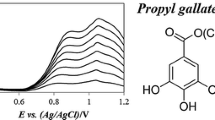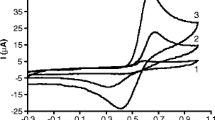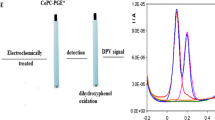Abstract
The present work is focused on investigating the effect of eugenol on oxidative decarboxylation of gallic acid in green tea by employing cyclic voltammetry (CV) technique. Such technique has been employed to examine the nature of variation of voltammograms obtained from green tea solutions subjected to different settling and boiling times, with particular emphasis on the oxidation of gallic acid (GA). The oxidation peak at −0.35 V in the voltammograms is observed to originate during decarboxylation process of GA to produce pyrogallol and carbon dioxide (CO2) which have several detrimental effects on human health. The controlled addition of eugenol during the preparation of tea has been observed to inhibit such decarboxylation.
Access this chapter
Tax calculation will be finalised at checkout
Purchases are for personal use only
Similar content being viewed by others
References
Donà M, Dell’Aica I, Calabrese F, Benelli R, Morini M, Albini A, Garbisa S (2003) Neutrophil restraint by green tea: inhibition of inflammation, associated angiogenesis, and pulmonary fibrosis. J Immunol 170(8):4335–4341
Osada K, Takahashi M, Hoshina S, Nakamura M, Nakamura S, Sugano M (2001) Tea catechins inhibit cholesterol oxidation accompanying oxidation of low density lipoprotein in vitro. Comp Biochem Physiol C Toxicol Pharmacol 128(2):153–164
Weber JM, Ruzindana-Umunyana A, Imbeault L, Sircar S (2003) Inhibition of adenovirus infection and adenain by green tea catechins. Antiviral Res 58(2):167–173
Sudano RA, Blanco AR, Giuliano F, Rusciano D, Enea V (2004) Epigallocatechin-gallate enhances the activity of tetracycline in staphylococci by inhibiting its efflux from bacterial cells. Antimicrob Agents Chemother 48(6):1968–1973
Haqqi TM, Anthony DD, Gupta S, Ahmad N, Lee MS, Kumar, GK, Mukhtar H (1999) Prevention of collagen-induced arthritis in mice by a polyphenolic fraction from green tea. Proc Nat Acad Sci 96(8):4524–4529
Raederstorff DG, Schlachter MF, Elste V, Weber P (2003) Effect of EGCG on lipid absorption and plasma lipid levels in rats. J Nutr Biochem 14(6):326–332
Chacko SM, Thambi PT, Kuttan R, Nishigaki I (2010) Beneficial effects of green tea: a literature review. Chin Med 5(1):1–9
Ziyatdinova GK, Nizamova AM, Aytuganova II, Budnikov HC (2013) Voltammetric evaluation of the antioxidant capacity of tea on electrodes modified with multi-walled carbon nanotubes. J Anal Chem 68(2):132–139
Lin H, Gan T, Wu K (2009) Sensitive and rapid determination of catechol in tea samples using mesoporous Al-doped silica modified electrode. Food Chem 113(2):701–704
Atomssa T, Gholap AV (2015) Characterization and determination of catechins in green tea leaves using UV-visible spectrometer. J Eng Technol Res 7(1):22–31
Kiani A, Raoof JB, Nematollahi D, Ojani R (2005) Electrochemical study of catechol in the presence of dibuthylamine and diethylamine in aqueous media: part 1. Electrochemical investigation. Electroanalysis Int J Devoted Fundam Pract Aspects Electroanalysis 17(19):1755–1760
Sun YG, Cui H, Li YH, Lin XQ (2000) Determination of some catechol derivatives by a flow injection electrochemiluminescent inhibition method. Talanta 53(3):661–666
Savolainen H (1992) Tannin content of tea and coffee. J Appl Toxicol 12(3):191–192
Li W, Wang C (2015) Biodegradation of gallic acid to prepare pyrogallol by Enterobacter aerogenes through substrate induction. BioResources 10(2):3027–3044
Guzmán-López O, Loera O, Parada JL, Castillo-Morales A, Martínez-Ramírez C, Augur C, Gaime-Perraud I, Saucedo-Castaneda G (2009) Microcultures of lactic acid bacteria: characterization and selection of strains, optimization of nutrients and gallic acid concentration. J Ind Microbiol Biotechnol 36(1):11–20
Goldberg I, Rokem JS (2019) Organic and fatty acid production, microbial, pp 358–382
Fiege H, Voges HW, Hamamoto T, Umemura S, Iwata T, Miki H, Fujita Y, Buysch HJ, Garbe D, Paulus W (2000) Phenol derivatives. In: Ullmann’s encyclopedia of industrial chemistry
Gupta YK, Sharma M (2001) Reversal of pyrogallol-induced delay in gastric emptying in rats by ginger (Zingiber officinale). Methods Find Exp Clin Pharmacol 23(9):501–504
Bruges G, Venturini W, Crespo G, Zambrano ML (2018) Pyrogallol induces apoptosis in human platelets. Folia Biol 64(1):23–30
Adeyemi JA, Arowolo OK, Olawuyi ST, Alegbeleye D, Ogunleye A, Bamidele OS, Adedire CO (2018) Effect of co-administration of green tea (Camellia sinensis) on clove-(Syzygiumaromaticum) induced hepatotoxicity and oxidative stress in Wistar rats
Kilmartin PA, Hsu CF (2003) Characterisation of polyphenols in green, oolong, and black teas, and in coffee, using cyclic voltammetry. Food Chem 82(4):501–512
Furuno K, Akasako T, Sugihara N (2002) The contribution of the pyrogallol moiety to the superoxide radical scavenging activity of flavonoids. Biol Pharm Bull 25(1):19–23
Kondo K, Kurihara M, Fukuhara K (2001) Mechanism of antioxidant effect of catechins. Methods Enzymol 335:203–217
Makuch E, Nowak A, Günther A, Peech R, Kucharski Ł, Duchnik W, Klimowicz A (2020) Enhancement of the antioxidant and skin permeation properties of eugenol by the esterification of eugenol to new derivatives. AMB Express 10(1):1–5
Fadilah AY, Yanuar A, Arsianti A, Andrajati R, Indah Paramita R (2017) Silico study, synthesis, and cytotoxic activity of esterification of eugenol and gallic acid against HT-29 cell line. Orient J Chem 33(6):3009–3014
Acknowledgements
The authors would like to acknowledge the Department of Electronic Science, University of Calcutta and WBDITE for providing infrastructural support.
Author information
Authors and Affiliations
Corresponding author
Editor information
Editors and Affiliations
Rights and permissions
Copyright information
© 2023 The Author(s), under exclusive license to Springer Nature Singapore Pte Ltd.
About this paper
Cite this paper
Roy, A., Bhattacharya, D., Das, C., Nag Chowdhury, B., Karmakar, A., Chattopadhyay, S. (2023). Voltammetric Detection and Controlled Inhibition of Decarboxylation of Gallic Acid (GA) in Green Tea Using Eugenol. In: Giri, C., Iizuka, T., Rahaman, H., Bhattacharya, B.B. (eds) Emerging Electronic Devices, Circuits and Systems. Lecture Notes in Electrical Engineering, vol 1004. Springer, Singapore. https://doi.org/10.1007/978-981-99-0055-8_15
Download citation
DOI: https://doi.org/10.1007/978-981-99-0055-8_15
Published:
Publisher Name: Springer, Singapore
Print ISBN: 978-981-99-0054-1
Online ISBN: 978-981-99-0055-8
eBook Packages: EngineeringEngineering (R0)




